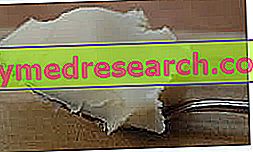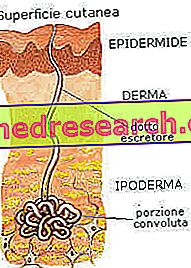Generality
Lard is a seasoning fat of animal origin; it is characterized by extreme resistance to heat (high smoke point) as opposed to low resistance to oxidative stress (strong tendency to become rancid). The lard is therefore suitable for use in cooking MA little suitable for storage in a NON-controlled environment (light, temperature, oxygen, etc.).
Lard production: the fat is obtained from the "excess" fat of the pig ( Sus scrofa domesticus ) by means of thermal fusion.

The procedure for the extraction of lard is in part aimed only at itself (when derived from adrenal fat) and partly bound to the production of greaves. Proceeding in order, to obtain lard it is necessary:
- Enter the adrenal fat and scuttards of subcutaneous skinned adipose tissue in a slow-heated and long-lasting cauldron
- Wait for the fusion of fats and the complete evaporation of tissue water
- Drain the liquefied fat into the lard containers and wait for the solidification
- Separately, press the remarkably shrunken pieces (as they are emptied of the triglycerides), possibly season them, and recover the last portion of fat obtained.
Lard: the last portion of edible recovery of the pig: as is well known, breeding pigs can be classified into two distinct strands: that of the beasts grown on a controlled diet and that of over-fed animals (typical Italian) . While the first group mainly contains the pigs used in the production of fresh meat, the second (famous heavy backyard pig) mostly represents pigs destined for the sale of preserved meat (salted, stuffed meat, etc.).
Every cut of the pig acquires a very precise role and destination. It is true that the lard is obtained from the excess fat portions but, both in the heavy and the light pig, this component (apart adrenal) is of fundamental importance for numerous preparations. In the light one, the subcutaneous fat is frequently attached to some cuts like the fresh belly, some chops, fresh ham etc. In the heavy pig, the subcutaneous fat goes to make up the lard, the guanciale, the schooner, the seasoned pancetta, the seasoned ham etc. furthermore, having removed the rind, it should be cut or ground to make the mixture of sausages such as sausages, salami, pot salami, zamponi, cotechino, salami from gravy, etc. After all, the subcutaneous fat for lard production is not very abundant!
Food quality and fatty acids in lard: it goes without saying that the lard of better organoleptic and gustatory quality is that with more subcutaneous fat and less adrenal. On the other hand, representing a recovery process for edible portions, sacrificing the best pieces of pork for lard production in itself would not be a well-considered choice.
As far as the chemical-physical properties of lard are concerned, let us remember that they (as well as the nutritional ones) vary considerably based on the diet imposed on the bred pig. Heavy pig lard (supercharged) is ALWAYS richer in saturated fat than light pork (proportionally more abundant in monounsaturated fatty acids). Furthermore, as regards the choice of the type of feed, it should be taken into consideration that (to make a striking example) the fabrics of the Black Nebrodi Pig (which feeds mainly on acorns, dried fruit, bulbs and tubers) are even rich in essential polyunsaturated fatty acids of the omega6 type.
| Nutritional composition of the Strutto or sugna - Reference values of the Food Composition Tables - INRAN | ||||||||||||||||||||||||||||||||||||||||||||||||||||||||||||||||||||||||||||||||||||
 | ||||||||||||||||||||||||||||||||||||||||||||||||||||||||||||||||||||||||||||||||||||
Nutritional values (per 100 g of edible portion)
| ||||||||||||||||||||||||||||||||||||||||||||||||||||||||||||||||||||||||||||||||||||
At this point a question arises:
How can the fatty acid composition of lard (or generically of pork) affect nutrition and human health?
It is soon said; the greatest quantity (both absolute and in relation to unsaturated fats) of saturated fats has positive and negative implications. A negative aspect concerns the impact on the state of human health; the excess of saturated fats (or a saturated / unsaturated ratio greater than 1/4), over time, can increase cholesterolemia, and therefore also cardiovascular risk. This is especially true if the excess of saturated fat is associated with a diet very rich in calories and a sedentary lifestyle; vice versa, a physically active organism subjected to a normocaloric or (better) slightly hypocaloric diet does not seem to be negatively affected by the excess of saturated fats.
A positive aspect instead concerns the "smoke point" of lard; saturated fats are more stable to heat and tend to better preserve their structural integrity than others when cooking at high temperatures (avoiding the production of toxic molecules). This determines an improvement in the organoleptic and gustatory quality of the food that contains them, as well as greater protection from carcinogenic and / or toxic catabolites. Remember that lard, being free of antioxidants, is NOT suitable for food preservation (except for the lard of raw ham).
Nutritional properties
Lard is a dressing fat useful for cooking but not recommended for storage, especially if it occurs at room temperature, with intense light and exposure to oxygen. It certainly contains cholesterol, although from the table below it is not possible to extrapolate its value, and even the high presence of saturated fats makes it a product that is inadvisable in the diet of hypercolesterolemic and of those who are characterized by a higher cardiovascular risk than normal.
The energy density of lard is obviously very high and almost comparable to that of a pure vegetable oil. Being perfect for the "frying" technique, it is recommended to use it at least sporadically in the diet.
NB : Lard is also used in the composition of some mixes based on flour and water; a practical example is the Ferrarese couple (bread), many baked goods (schiacciate, pinzini etc.), the piadina romagnola (bread) and many others. Below is the video recipe for preparing traditional Romagna piadina with lard; the most attentive to the line will instead prefer the light variant - vegan piadina without lard with olive oil.
Recipe for Piadina - How to make Piadine
X Problems with video playback? Reload from YouTube Go to Video Page Go to Video Recipes Section Watch the video on youtube



